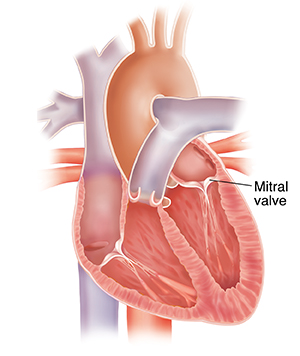Understanding Open Mitral Valve Replacement
A mitral valve replacement is a surgery to replace a mitral valve that doesn’t work well. It’s replaced with a new valve. This needs open heart surgery. It’s done with an incision in the middle of the chest that goes through your breastbone (the sternum).

Why mitral valve replacement is done
The mitral valve is one of the heart’s 4 valves. These valves help the blood flow move forward in 1 direction through the heart’s 4 chambers and out to the body. The mitral valve lies between the left atrium and the left ventricle.
The surgery is done if you are having severe symptoms or if the mitral valve is working poorly. This may be the case if you have either of the below:
-
Mitral valve regurgitation. This is also known as mitral valve insufficiency. This is a leaky valve that lets blood flow backward in the heart. This can occur because of a heart defect you were born with, damage from a heart attack, advanced age, or a bacterial infection in your valve.
-
Narrow mitral valve. This is also known as mitral stenosis. The mitral valve opening is narrowed. This can limit the blood moving forward from the left atrium to the left ventricle or the heart's main pumping chamber. As a result, blood can back up in the lungs. You might have been born with this narrowed valve. But it can also occur because of damage from rheumatic fever
These conditions can put stress on the heart and lead to symptoms, such as shortness of breath, cough, chest pain, fatigue, and swelling in your body. A new valve can let blood flow through your heart and out to your body normally again.
How mitral valve replacement is done
Your procedure will be done by a cardiac surgeon. This is a healthcare provider who uses surgery to treat diseases of the heart. They will work with a specialized surgical team. You will be hooked up to a heart-lung machine. This machine will act as your heart and lungs during the surgery. The surgeon will make a cut (incision) down the middle of your chest. To reach your heart, the healthcare provider will separate the breastbone. This is called a sternotomy. They will take out your mitral valve and replace it with a new valve. Afterwards, your sternum will be put back together with surgical wires.
Risks of open mitral valve replacement
All surgery has some risks. The risks of open mitral valve replacement include:
-
Infection
-
Bleeding
-
Irregular heart rhythms
-
Blood clots that can lead to stroke or heart attack
-
Complications from anesthesia
-
Damage to the arteries of the heart
-
Death
Your own risks may vary based on your age, your general health, and the reason for your procedure. They may also vary depending on the structure of your heart. Talk with your healthcare provider about which risks apply most to you.
Online Medical Reviewer:
Callie Tayrien RN MSN
Online Medical Reviewer:
Mary Mancini MD
Online Medical Reviewer:
Stacey Wojcik MBA BSN RN
Date Last Reviewed:
3/1/2022
© 2000-2025 The StayWell Company, LLC. All rights reserved. This information is not intended as a substitute for professional medical care. Always follow your healthcare professional's instructions.